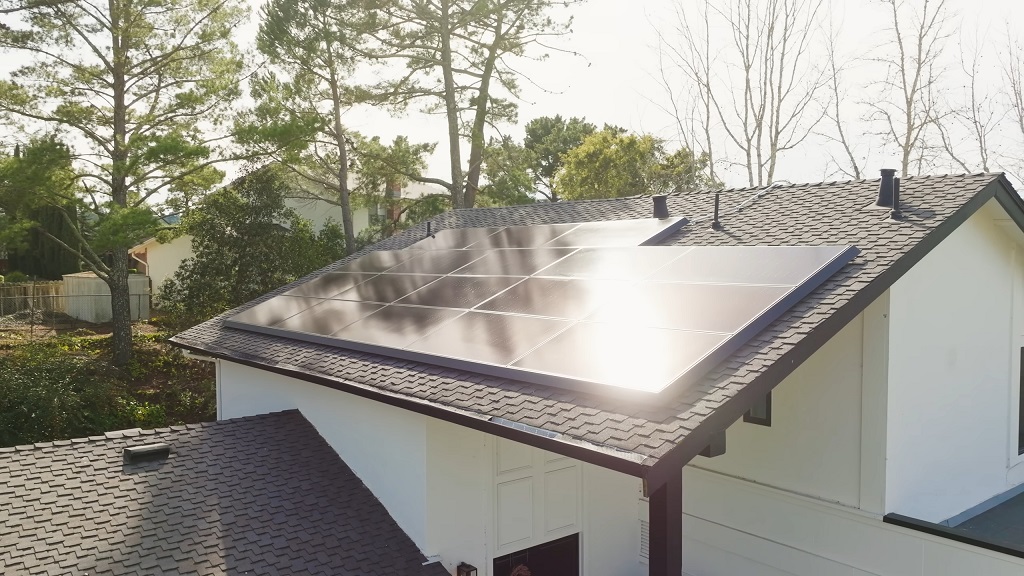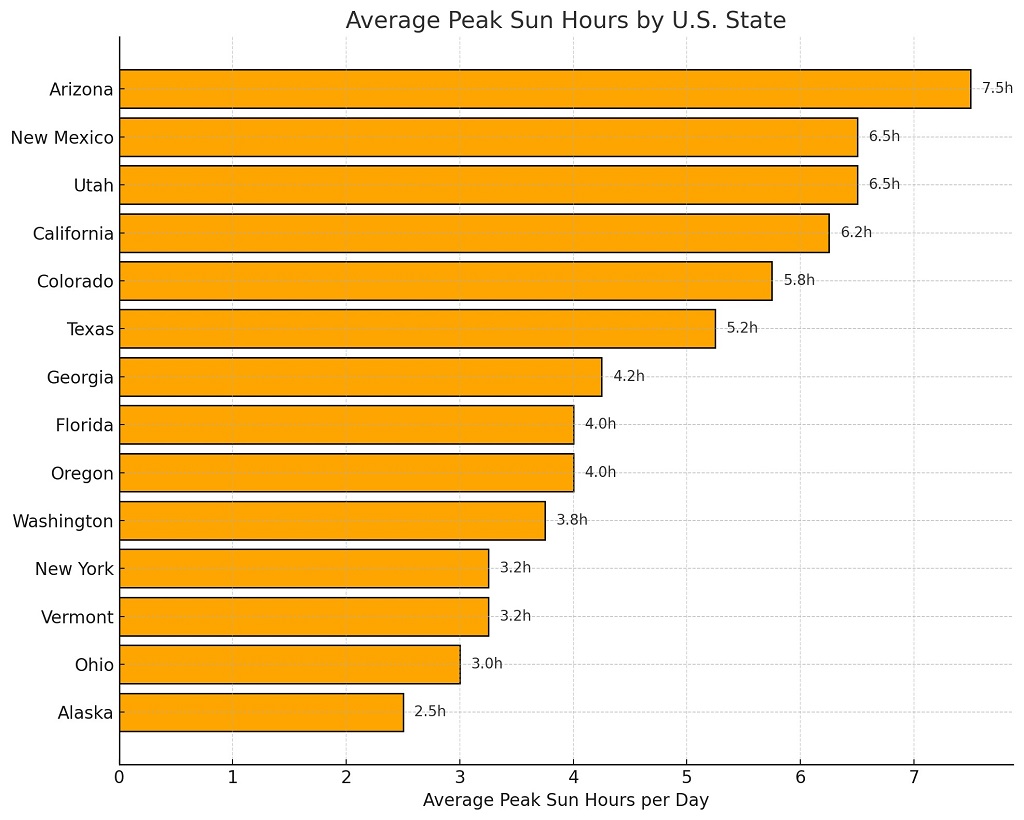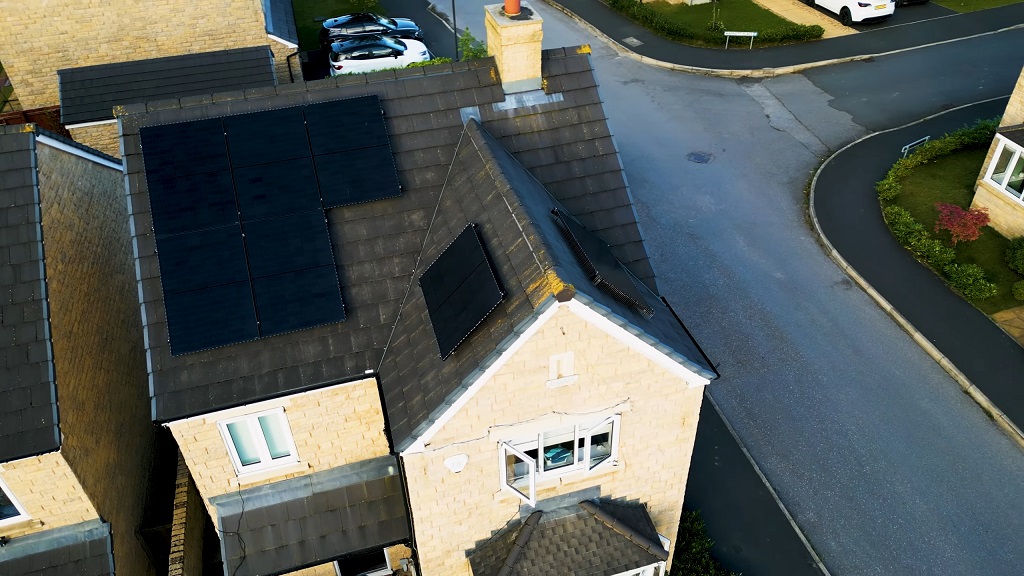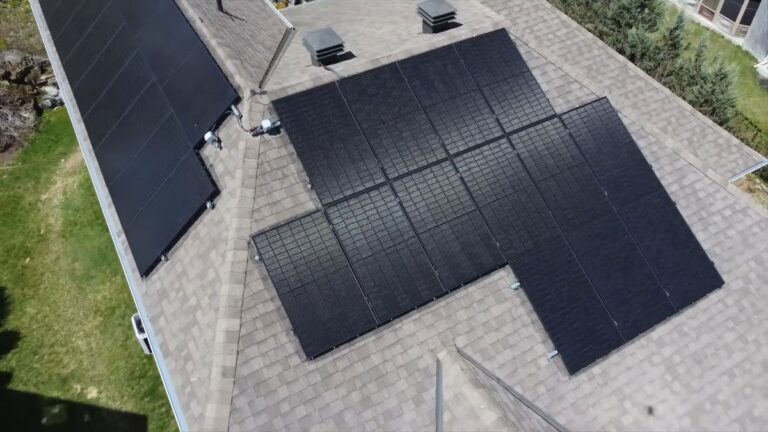Thinking about solar panels? You’re not alone. More homeowners across the U.S. are tapping into solar energy, not just because it’s cleaner, but because it can save a lot of money over time.
But there’s one thing that often gets overlooked in the excitement: peak solar performance hours.
That term might sound like it belongs in a physics textbook, but it’s actually a down-to-earth concept that plays a huge role in how well your solar system performs.
And whether you live in sunny Arizona or cloudy Vermont, it’s something you’ll want to get familiar with before signing any contracts or installing your panels.
Let’s break it down.
Peak Solar Performance Hours Explained

Peak solar performance hours – or more commonly, peak sun hours – are the hours during the day when sunlight hits your solar panels with enough intensity to produce electricity at full rated capacity.
To be more specific, one peak sun hour equals one hour of solar radiation averaging 1,000 watts per square meter. That’s roughly the strength of the sun around noon on a clear summer day.
So if you get 5 peak sun hours in a day, it doesn’t mean the sun was shining for only five hours.
It means your panels were exposed to enough intense sunlight to produce their full rated power for the equivalent of five full hours.
Think of it like this:
| Daily Solar Radiation | Peak Sun Hours |
| 6 kWh/m² | 6 hours |
| 4.5 kWh/m² | 4.5 hours |
| 2.8 kWh/m² | 2.8 hours |
Why Peak Sun Hours Matter
Here’s where things get practical. Peak sun hours directly impact how much electricity your system can produce, how big your setup needs to be, and how much you’re likely to save.
Sizing Your System Correctly

Let’s say you use 25,000 kilowatt-hours (kWh) of electricity annually. That’s a bit above average, but not unheard of – especially for homes with large families or EVs.
If you live in a state like Texas, which averages around 5.5 peak sun hours a day, you’d calculate your system size like this:
- 25,000 kWh ÷ 365 = 68.5 kWh/day
- 68.5 ÷ 5.5 = 12.45 kW system
That tells you that you’ll need a solar system around 12.5 kilowatts in size. Add a little extra to account for cloudy days, panel inefficiency, or future energy needs, and you’re in the right ballpark.
If you’re estimating a 12.5 kW system in Texas, or something similar in Brisbane, installers such as BSS Brisbane Solar Systems can perform a detailed shade and angle analysis for you.
Optimizing Energy Use
Knowing when your panels are working hardest lets you schedule energy-heavy tasks – laundry, charging your EV, running the pool pump – during peak hours, when your system is producing more than you need.
It’s an easy way to reduce what you pull from the grid.
Planning Your Budget and Payback
The number of peak sun hours where you live affects how much electricity your system will generate – and therefore, how quickly you’ll recoup your investment.
More sun, faster payback. But that doesn’t mean solar isn’t worth it in cloudier regions. Local incentives, electricity rates, and net metering policies also play a big role.
Peak Sun Hours by State
So how many peak sun hours does your state get? Here’s a quick look at the national spread:

High solar states like Arizona, Nevada, and New Mexico are top-tier when it comes to solar potential.
But you can still make solar work in lower sun states – it just takes more planning and possibly a slightly larger system.
What Affects Peak Sun Hours?
Your state’s average is a starting point, but every home has its own quirks. Here’s what else can influence your peak solar hours:
Latitude
Cities closer to the equator naturally get stronger, more direct sunlight. Phoenix sees more peak sun hours than Seattle for a reason.
Seasonal Changes
Expect more peak hours in summer, fewer in winter. For example, Las Vegas gets around 7.13 peak sun hours in July, but only 5.84 in January.
Climate and Weather
Clouds, haze, humidity, and air pollution can all reduce solar radiation. The Pacific Northwest tends to have lower solar performance due to persistent cloud cover.
Your Roof’s Orientation and Angle
A south-facing roof (in the Northern Hemisphere) with little shading and an angle that matches your latitude? That’s the sweet spot.
Even small tweaks – like trimming a tree or adjusting tilt with a mounting bracket – can improve output noticeably.
How to Calculate What You Need

Let’s walk through a real-world scenario.
Say you use 30,000 kWh per year. You live in North Carolina, which gets around 4.25 peak sun hours a day.
- 30,000 ÷ 365 = ~82.2 kWh/day
- 82.2 ÷ 4.25 = 19.35 kW system
You’d likely install a 20 kW system to meet your needs comfortably, accounting for cloudy days and some efficiency loss.
If that number sounds high, it might be! The average U.S. home uses around 10,000–11,000 kWh per year, meaning most people get by with a 6–10 kW system, depending on where they live.
Online tools like NREL’s PVWatts Calculator or SolarReviews.com’s estimator can help you plug in your numbers and get a clearer idea.
Smart Ways to Maximize Peak Sun Hours

You can’t control the weather, but you can take steps to squeeze every watt out of your panels.
Use Energy When the Sun Shines
Set appliances to run midday – dishwasher, dryer, water heater, even your car charger. Most solar systems perform best from around 10 AM to 3 PM.
Consider Battery Storage
A system like the EcoFlow DELTA Pro stores excess energy generated during peak hours for use in the evening or on cloudy days. Great for grid independence or just lowering your monthly bill.
Monitor Your System
Use your solar company’s app to track how your panels are performing hour by hour. This helps you spot issues, plan usage, and even brag a little when you see those summer spikes.
Install Smart
Choose an unshaded area with south (or near-south) exposure. If your roof isn’t ideal, ground-mount systems or even solar carports can be a great alternative.
Upgrade With Solar Trackers
If you’ve got the budget, a solar tracker system that follows the sun across the sky can increase output by up to 25%. Not essential, but handy in lower-sun areas.
Tips Before You Install
Before calling up an installer or signing any paperwork, it helps to get prepared:
- Look up your ZIP code’s peak sun hours on tools like Unbound Solar’s Sun Hours Map.
- Compare multiple quotes – panel types, warranties, and system designs can vary a lot.
- Factor in incentives – the 30% federal solar tax credit is still active, and many states offer additional rebates or net metering.
- Think ahead – If you plan to buy an electric car or add an HVAC system in a year or two, size your solar system accordingly.
- Ask about shading – Even one tall tree can drop your efficiency by 10–30%. Your installer should do a shade analysis as part of the estimate.
Final Thoughts
Peak sun hours might not be the flashiest part of going solar, but they’re absolutely one of the most important. They shape everything from how big your system needs to be to how much money you’ll save in the long run.
And the good news? You don’t need a degree in solar engineering to make smart decisions. Just a bit of local info, a calculator (or a good installer), and a few smart habits can set you up for decades of clean, efficient energy.

